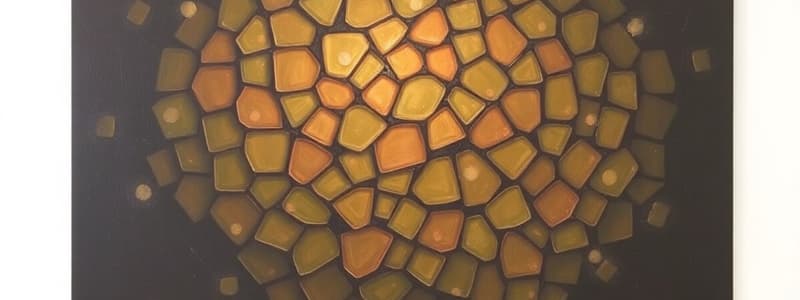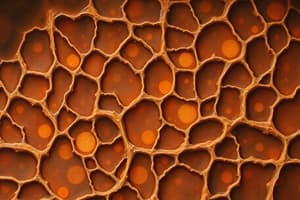Podcast
Questions and Answers
Which type of connective tissue cell is responsible for producing and maintaining the extracellular matrix (ECM)?
Which type of connective tissue cell is responsible for producing and maintaining the extracellular matrix (ECM)?
- Fibroblasts (correct)
- Macrophages
- Adipocytes
- Mast Cells
What is the primary function of elastic fibres in connective tissue?
What is the primary function of elastic fibres in connective tissue?
- Allowing tissues to stretch and recoil (correct)
- Providing tensile strength and resistance to stretching
- Storing fat for energy and insulation
- Supporting soft tissues and forming a mesh-like structure
Which of the following is NOT a characteristic of the extracellular matrix (ECM) of connective tissue?
Which of the following is NOT a characteristic of the extracellular matrix (ECM) of connective tissue?
- It directly contributes to the production of collagen fibres (correct)
- It provides structural integrity to connective tissue
- It contains water, proteins, and glycoproteins
- It is a gel-like substance
What is the primary role of macrophages in connective tissue?
What is the primary role of macrophages in connective tissue?
Which type of connective tissue fibre is most abundant in tendons and ligaments?
Which type of connective tissue fibre is most abundant in tendons and ligaments?
Which of the following is NOT a function of connective tissue?
Which of the following is NOT a function of connective tissue?
Which connective tissue cell type is primarily involved in immune defense?
Which connective tissue cell type is primarily involved in immune defense?
Which of the following statements correctly describes the ECM of connective tissue?
Which of the following statements correctly describes the ECM of connective tissue?
Flashcards
What is connective tissue?
What is connective tissue?
Connective tissue is a type of tissue responsible for providing support, protection, transport, insulation, and storage. It is made up of cells, fibers, and an extracellular matrix.
What are the functions of connective tissue?
What are the functions of connective tissue?
The main functions of connective tissue include: supporting tissues and organs, protecting cells and organs, transporting substances, insulating the body, and storing energy.
Describe the extracellular matrix of connective tissue.
Describe the extracellular matrix of connective tissue.
Connective tissue is characterized by its extracellular matrix, a gel-like substance surrounding the cells. It provides structural support, allows for nutrient and waste transport, and varies depending on the specific tissue type.
What is the function of fibroblasts?
What is the function of fibroblasts?
Signup and view all the flashcards
What are adipocytes?
What are adipocytes?
Signup and view all the flashcards
What is the function of macrophages?
What is the function of macrophages?
Signup and view all the flashcards
What are collagen fibers?
What are collagen fibers?
Signup and view all the flashcards
What are elastic fibers?
What are elastic fibers?
Signup and view all the flashcards
Study Notes
Connective Tissue Functions and Characteristics
- Connective tissue provides structure to tissues and organs (e.g., bones, ligaments).
- It protects organs by providing immune defence, wound healing, and cushioning.
- It facilitates transport of nutrients, water, and waste products (e.g., blood).
- It insulates and stores energy (e.g. fat tissue).
- Connective tissue is composed of cells, fibers, and an extracellular matrix (ECM).
Extracellular Matrix (ECM)
- The ECM is a gel-like substance surrounding and supporting cells.
- It's composed of water, proteins, glycoproteins, and glycosaminoglycans.
- The ECM provides structural integrity and facilitates transport of nutrients and waste.
- Its properties differ depending on the tissue type (e.g., calcified in bone, flexible in cartilage).
Connective Tissue Cells (Fixed and Transient)
- Fixed cells:
- Fibroblasts: produce and maintain fibers (collagen, elastic) and ECM.
- Adipocytes: store fat for energy, insulation, and cushioning.
- Macrophages: engulf pathogens and dead cells (immune defense).
- Mast cells: release histamine during allergic reactions, contributing to inflammation.
- Transient cells:
- Plasma cells: produce antibodies to combat infections.
- Eosinophils: combat parasites and participate in allergic responses.
Connective Tissue Fibers
- Collagen fibers: thick fibers providing tensile strength, resisting stretching; abundant in tendons and ligaments.
- Elastic fibers: thin fibers allowing tissues to stretch and recoil; found in skin, lungs, and arteries.
- Reticular fibers: thin, branching fibers forming a mesh-like structure supporting soft tissues like spleen and lymph nodes.
Types of Connective Tissue (Proper and Specialized)
-
Connective Tissue Proper:
- Loose connective tissue (Areolar): binds skin to underlying structures, supports blood vessels.
- Loose connective tissue (Adipose): stores fat, insulates the body, cushions organs.
- Loose connective tissue (Reticular): supports lymphoid organs (e.g., spleen, lymph nodes).
- Dense Regular Connective Tissue: parallel collagen fibers for strength (tendons, ligaments).
- Dense Irregular Connective Tissue: densely packed fibers in random directions for strength (dermis).
- Elastic Connective Tissue: contains mostly elastic fibers for stretch and recoil (arteries, lungs).
-
Specialized Connective Tissue:
- Cartilage (hyaline, fibrocartilage, elastic).
- Bone (compact and spongy bone).
- Blood: transports oxygen, nutrients, waste; involved in immune defense and clotting.
Studying That Suits You
Use AI to generate personalized quizzes and flashcards to suit your learning preferences.




